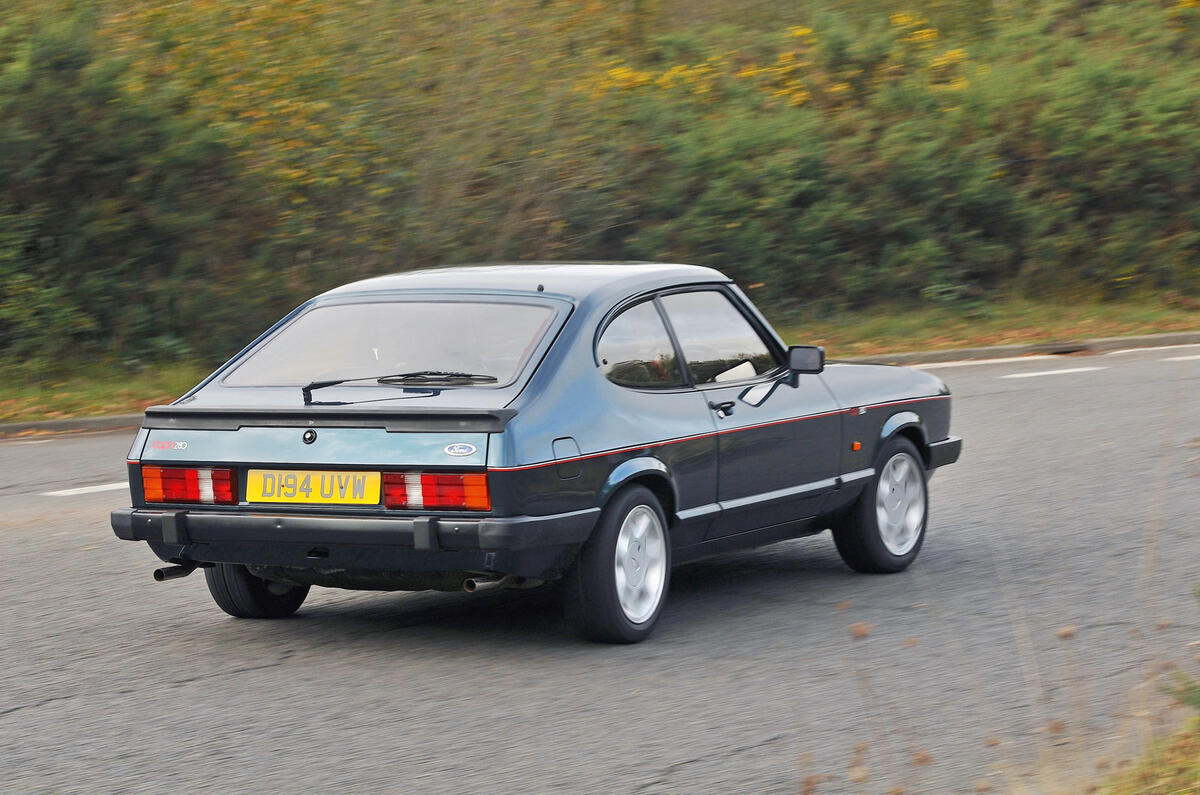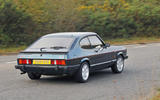By relocating a single letter, you form what sounds like the word that for many people best described the Capri, a sporty coupé that endured from 1969 to 1986. That was then but, today, a good Capri is a desirable old thing.
It’s the third and final generation – launched in 1978 and known, not surprisingly, as the Mk3 – that we’re interested in here. Production ended in 1986 but it took until 1989 for the last example, a 280 Brooklands, to be registered, which tells you all you need to know about this fast Ford’s fading appeal.
If only we’d known then what we know now. In 1989, a Brooklands cost around £12,000, but today the best go for as much as £40,000. In the real world, prices for a good Mk3 start at around £8000 but you can get into a tidy 1.3 or 1.6 for £3500. That’s ‘tidy’ as in ‘not as rusty as you might imagine’ because there will be rust. Where there isn’t any, assume it’s because you’re looking at filler.
Click here to buy your next used car from Autocar
The Mk3 was little more than a refreshed Mk2, which actually was very successful. It used the same Cortina-derived running gear and engines. These ranged from a 1.3 to a 3.0 V6, the latter also available in torquey S form and breathing through three Weber carbs. Styling-wise, the most successful tweak was the way the bonnet extended slightly over the new quad headlights to give a more aggressive appearance. The car was more aerodynamic, too, and the most powerful versions had a discreet rear spoiler.

In 1982, the 3.0 engine was replaced by a cleaner 2.8 with fuel injection. Early versions of this unit had a four-speed gearbox. The 2.8i Special appeared with a five-speed ’box and a limited-slip diff in 1984. The 1.3 and 1.6 versions gave people a step up into Capri-land but it was the 2.0 that was the big seller. By 1984, the UK was the only country taking the Capri. In 1986, Ford had a final throw of the dice with the Capri 280 Brooklands, based on the 2.8i Special and finished in racing green. It was the last version off the production line.
Depending on the engine, you could have your Capri in L, GL, Ghia, Laser or S trims, but today such niceties have been elbowed aside by vehicle condition. Even mileage isn’t an issue because, at this distance, you’ll be wanting to lift the head and generally fettle anything that moves.
Depending on what you’re looking for, the parts situation is either okay or dire. At least, in the absence of good steel ones, someone’s making plastic bonnets now. Beware cars with poor interiors since trim is hard to source.
We joke about the name but the Capri is a lovable rogue. Just check for rust and filler, and don’t pay over the odds.
How to get one in your garage

An expert's view
Martin Pawson, founder of Capri Gear: “I started my business in 1994 breaking Capris but today, with prices rising, I spend more time restoring and servicing them. There are a lot of awful, patched-up Capris out there but people just fall for the looks every time. There are fakes, too, such as 3.0-litre cars with 1.6 Laser body shells. The spares situation is getting critical, with many parts now scarce or unavailable. Corrosion is the big enemy. The mechanicals are easy to fix. My favourite is an early 2.8i fourspeed – not the Brooklands, because it was thrown together.”
Buyer beware…
â– Bodywork: The body is a rust trap. Outer and inner wings, wheel arches, sills, door bottoms, chassis rails, suspension turrets, hinge mounts and even the fuel tank can all rot out spectacularly.
â– Engine: We could go on about the way V6s blow their gaskets and can even warp, how 2.0-litre Pinto engines suffer a worn camshaft, big-ends knock, the exhaust smokes, Ford carbs on base models can be troublesome from cold, the 2.8i K-Jetronic system fills with rust if unused… but, really, just expect the worst and check everything. This includes the condition of HT leads, watching out for mayonnaise sludge around the oil filler, for overheating issues caused by a clogged radiator and for leaks from the same.
â– Gearbox: Keep an ear out for crunchy synchros and for propshaft rumbles, vibration and whines. A badly worn ’box will jump out of gear on the overrun.
â– Steering, suspension: Some Mk3s are now over 40 years old so are exempt from the MOT test – more reason to check safety-critical items such as springs, dampers, strut top mounts and track control arm bushes as well as the steering rack.
â– Brakes: Tired brake hoses, rusty and warped discs and seized calipers are all possible, especially if the car has been rarely used.

â– Interior: Walk away from anything too tired or worn because sourcing replacement trim can be difficult.
Also worth knowing
The Capri Club (capriclub.co.uk) is a good place to start your spares hunt. Tickover (tickover.co.uk) is another and so is Capri Gear (caprigear.co.uk), which can also supply responsibly sourced used parts. Online traders are another source of used parts but some pay little attention to environmental regulations when breaking vehicles.
How much to spend
£1500 -£3999: Project cars, including a 2.0 Laser, but also some 1.3 runners. Recently, a 1981-reg 1.3 Cameo with 105,000 miles made £3300 at auction.
£4000-£6000: Mainly 1.6s and 2.0s, including a 1979 2.0 with MOT, new brakes and engine overhaul for £6000.
£6001-£7999: More 2.0s, including a 1985-reg £6500 Laser. Also some auction buys, such as a 1985-reg 2.8i that made £7400.
£8000-£10,999: 2.0 and 2.8i cars in good condition.
£11,000-£19,999: Low-mileage, low-owner Capris in top condition.
£20,000-£40,000: Mainly concours-grade 2.8i Brooklands.
One we found

Ford Capri 2.8i, 1984/A, 114,000 miles, £8500: Well-maintained 2.8i clearly owned by a level-headed enthusiast and in largely original condition. Lots of new parts, including clutch, front wheel bearings, control arms and brakes. The interior is in tidy condition, too.
READ MORE
What has Ford ever done for us?
New Ford Mondeo to launch in 2021, official document reveals
Finding the best hot Ford Fiesta of all time













Join the debate
Add your comment
By relocating a single letter...
...you form what souds like the word that for many people best described the Capri. I worked at a Ford dealership in the late 80s, a mate of mine there used to do exactly that rearrangement of letters with the badges on customer Crapis, I mean, Capris!
I want this problem
"There are fakes, too, such as 3.0-litre cars with 1.6 Laser body shells"
Loved them in their day
I owned a couple of Mk3s in the 80s and easrly 90s - a 2.0 Laser and a 2.8i Special - and my dad had a Mk1 and a couple of Mk2s back in the day. Loved them probably more than any car I've owned since, and the fun you could have on damp roads at legal speeds was amazing - and best kept to low speeds with those brakes...! Have idly thought about buying one now for old times' sake, but sometimes it's better to have the memories than face the reality that by modern standards (like almost any car from that era) they're really compromised (not to mention the rust, which usually bubbled through before the first MoT).